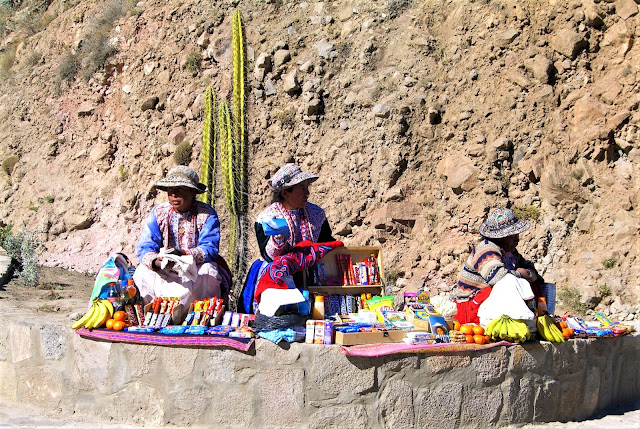Depending on who you talk to, the Cañón
del Colca in southern Peru is the third or fourth, or maybe the fifth, deepest
canyon in the world.
Some say Nepal’s Kali
Gandaki Gorge holds the title. Where the river runs between the peaks of
Annapurna and Dhaulagiri the elevation difference reaches 5,570 meters (18,275
feet). For others the Tsangpo Canyon in Tibet is the deepest; though listed at
5,500 meters (18,000 feet) deep, at one point the river flows 6,009 meters
(19,714 feet) below the land above it.
Then there’s the DenmanGlacier, hidden under the snows of Antarctica. Reaching 3,500 meters (11,500
feet) below sea level doesn’t make it the deepest in relation to the land
around it, but it does make this glacier-carved valley the lowest point of dry
land on Earth.
Cañón del Colca, then, seems to sit at #3
on the list of World’s Deepest Canyons. With a maximum depth of 3,501 meters, this
remarkable hole in the ground is fully twice as deep as the Grand
Canyon in Arizona, USA.
Which is nice. But that’s
not why we’re here.
Like most of the
150,000 or so people who come out here every year, I saw Colca Canyon from a
lookout near the high-altitude town of Chivay. At 3600 meters
(12,000ft) this region is where the grazing of livestock upstream gives way to agricultural
endeavors. It is also where the Colca Valley deepens enough to attain true canyon
status.
If you are suspicious about this rut in the
dirt being twice as deep as the Grand Canyon, you are forgiven. The lookouts near
Chivay are only around 1200 meters (3900ft) above the Colca River flowing by
down below.
 |
| Chivay's Parroquia Nuestra. Sra. de la Asunción (Parish of Our Lady of the Assumption) |
So why are
we here?
Because this place
rocks, that’s why. More specifically, this is an exceptional area to see
ample evidence of the system of terraced agriculture that has existed here
since before the rise of the Incan Empire.
No one is sure exactly when, but at some point the
Cabanas, an insanely ambitious bunch, moved here from
Lake Titicaca. Straddling the Peru-Bolivia border, a couple hundred meters above
Chivay, Lake Titicaca is large enough to fit five Londons or six Los Angeleses,
with enough room left over for a few Mt. Fujis. All that space apparently didn’t
suit the Cabanas, so they moved here and proceeded to turn the steep slopes of
the valley-turning-canyon into countless agricultural terraces.
These terraces, called andenes, have been in
existence in some form or another since 2,000 BC. I get a backache just hoeing
my wife’s vegetable garden, so I can only imagine the demand for chiropractic
services in South America over the past four millennia.
The Incas, said to have originated in the
Peruvian highlands in the early 13th Century, came down to the area
around Chivay about 1320 AD. They believed the river – here the Colca, downstream
the Majes then the Camana – flowed directly to the Milky Way. The Incas thus fell into the
habit of tossing gifts and sacrificial bits into the water.
The Incas moved into the neighborhood
relatively peacefully, establishing their dominion over the area largely through
marriage. The 16th Century Spaniards on the other hand took a brutally
violent approach, led by a real asshole named Gonzalo Pizarro. In the 1570s they
forced the Incas and the Cabanas they hadn’t already slaughtered to relocate to
places called ‘reductions’ – which are kind of like Indian reservations except
you roll the first r.
Meant to control the indigenous people,
collect taxes from them, conscript their labor for the mines (those Spaniards
love their gold), and facilitate the introduction of Jesus, these ‘reducciones’
were also called ‘congregaciones’ to really give them that Christian flair.
Gazing out over the canyon is enough to
make you forget about the Spaniards even as you ponder God. The amount of work
that must have gone into the creation of the innumerable, unbelievable andenes
can make the mind spin itself blank.
Then there are the birds.
The Cañón
del Colca is home for the giant Andean condor, the largest flying bird in the
world by combined measurement of weight and wingspan, the latter reaching more
than ten feet. This condor is also one of the world’s longest-living birds,
with a lifespan that can reach 70 years.
As morning rolls over the land and the cool air
at the bottom of the canyon slowly warms and rises, the condors spread their
wings and glide effortlessly upward, riding the vertical draft.
Aside from the condors, notable denizens of
the canyon include the Giant Hummingbird – the largest species of hummingbird
in case it isn’t obvious – and the wild vicuña, second cousin to the llama and, it is argued, ancestor to
the more domesticated alpaca.
The Incas regarded the vicuña as something pretty
special, protecting them by law and using their fine wool to make garments that
only royalty were allowed to wear. The Spaniards apparently weren’t much for
fine wool if they couldn’t spin it into gold, and through the centuries the vicuña population
declined due to hunting until 1974 when they only numbered around 6,000. Thanks
to conservation efforts they are no longer endangered, with 350,000 of them
partying it up with legal immunity.
 |
| Vicuñas. I think. |
Still, with their wool fetching upwards of
$300/kilogram they are ripe for poaching. Over 20,000 kilograms of vicuña wool
hits the black market every year. To combat this, conservation efforts include
rounding up and shearing vicuñas with hair longer than 2.5 centimeters.
A scarf
made of vicuña wool goes for around $1,500. A trip to Peru
and Colca Canyon can be had for much less. Trust me.
Then send me the difference. I want to go back.









No comments:
Post a Comment